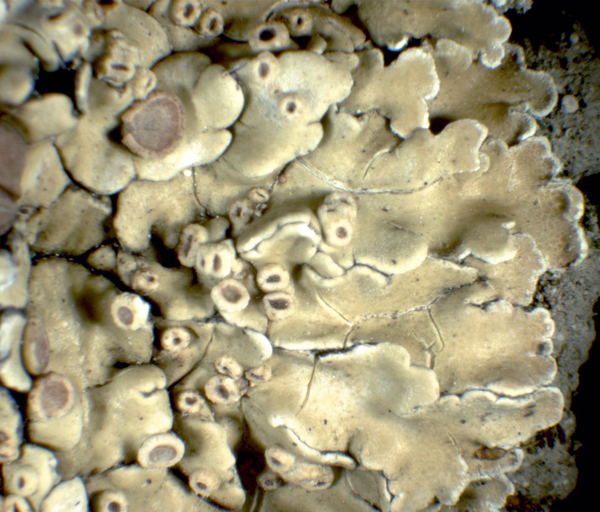Squamarina cartilaginea f. pseudocrassa (Mattick) S.Y. Kondr.
in Kondratyuk & Zelenko, Ukr. bot. Zh., 59, 5: 598-607, 2002. Basionym: Lecanora lentigera var. pseudocrassa Mattick - Ber. deutsch. bot. Ges., 58: 352, 1940.
Synonyms: Squamarina cartilaginea var. pseudocrassa (Mattick) D. Hawksw.; Squamarina crassa f. pseudocrassa (Mattick) Poelt
Distribution: N - VG (Martellos & al. 2014), Frl (Martellos & al. 2014), Ven (Martellos & al. 2014), TAA (Martellos & al. 2014), Lomb (Martellos & al. 2014), Emil (Martellos & al. 2014, Fariselli & al. 2020), Lig (Martellos & al. 2014). C - Tosc (Martellos & al. 2014), Abr (Martellos & al. 2014), Sar (Martellos & al. 2014). S - Camp (Martellos & al. 2014), Cal (Martellos & al. 2014), Si (Martellos & al. 2014)
Description: Thallus squamulose, yellowish green to whitish grey-green, often white-pruinose, especially at the margin of squamules, loosely to firmly attached. Squamules slightly concave to convex, contiguous to imbricate, usually aggregated to form a large thallus, the marginal ones sometimes slightly elongated. Lower surface pale to dark brown. Upper cortex paraplectenchymatous; medulla white, thick. Apothecia lecanorine, sessile, strongly constricted at base, up to 5 mm across, with a brownish to rarely reddish brown, smooth, concave to finally convex disc, and a pruinose thalline margin which tends to disappear in mature apothecia. Epithecium brownish, granular, 10-30 μm thick, sometimes penetrating into the hymenium; hymenium (I+ blue) and hypothecium colourless; paraphyses slightly thickened above. Asci 8-spored, clavate to cylindrical-clavate, the apical dome K/I+ dark blue, the wall I-, but the thin outer gel I+ blue, Bacidia-type. Ascospores 1-celled, hyaline, oblong-obtuse, thin-walled, (10-)12-14(-15) x 4-6 μm. Pycnidia dark, immersed. Conidia filiform. Photobiont chlorococcoid. Spot tests: thallus K-, C-, KC- or KC+ yellowish, P-; medulla P-. Chemistry: usnic acid (cortex). Note: see note on f. cartilaginea.
Growth form: Squamulose
Substrata: rocks, soil, terricolous mosses, and plant debris
Photobiont: green algae other than Trentepohlia
Reproductive strategy: mainly sexual
Commonnes-rarity: (info)
Alpine belt: absent
Subalpine belt: extremely rare
Oromediterranean belt: very rare
Montane belt: rather rare
Submediterranean belt: rather common
Padanian area: extremely rare
Humid submediterranean belt: extremely common
Humid mediterranean belt: very common
Dry mediterranean belt: very common
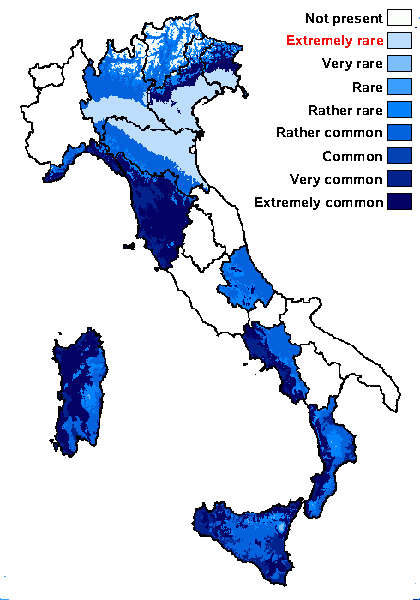
Predictive model
Herbarium samples
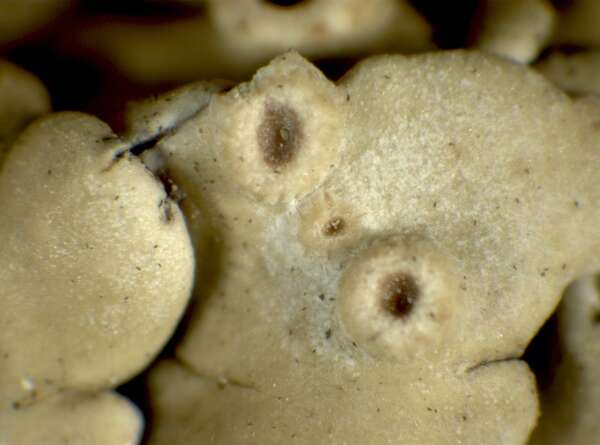

P.L. Nimis; Owner: Department of Life Sciences, University of Trieste
Herbarium: TSB (26252)
2001/12/11
young apothecia
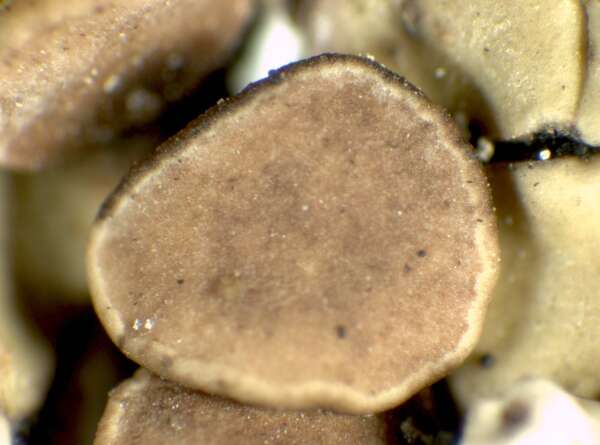

P.L. Nimis; Owner: Department of Life Sciences, University of Trieste
Herbarium: TSB (26252)
2001/12/11
old apothecium
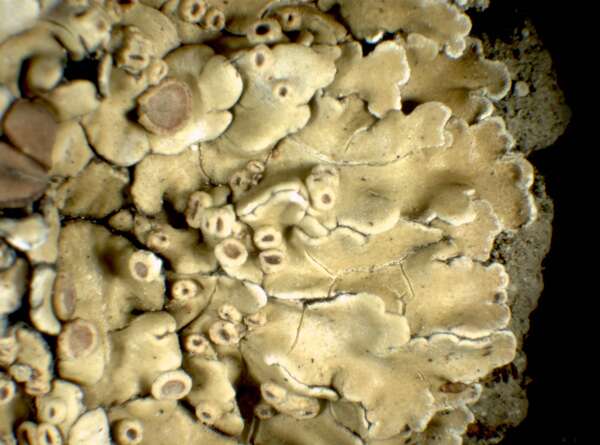

P.L. Nimis; Owner: Department of Life Sciences, University of Trieste
Herbarium: TSB (26252)
2001/12/11
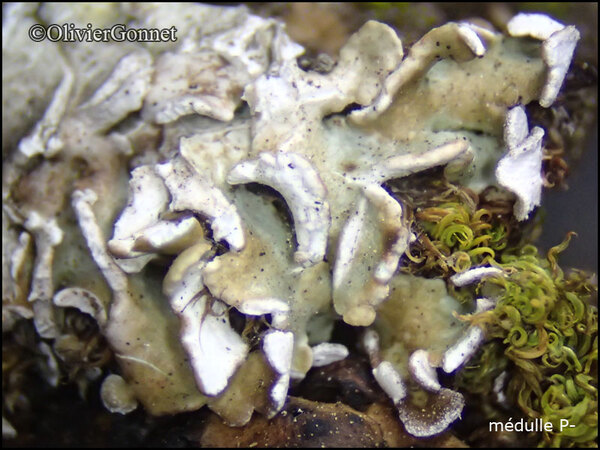
Courtesy Danièle et Olivier Gonnet - Source: https://www.afl-lichenologie.fr/Photos_AFL/Photos_AFL_S/Text_S3/Squamarina_cartilaginea_pseudocrassa.htm
France, 10/09/2015 - Saint-Bonnet-le-Bourgalt. 985 m - Puy-de-Dôme - (63) - étang de Marchaud, sur rocher émergé de l’étang - leg. C. Hurtado, herb. et det. D. et O. Gonnet
Growth form: Squamulose
Substrata: rocks, soil, terricolous mosses, and plant debris
Photobiont: green algae other than Trentepohlia
Reproductive strategy: mainly sexual
Commonnes-rarity: (info)
Alpine belt: absent
Subalpine belt: extremely rare
Oromediterranean belt: very rare
Montane belt: rather rare
Submediterranean belt: rather common
Padanian area: extremely rare
Humid submediterranean belt: extremely common
Humid mediterranean belt: very common
Dry mediterranean belt: very common

Predictive model
| Herbarium samples |


P.L. Nimis; Owner: Department of Life Sciences, University of Trieste
Herbarium: TSB (26252)
2001/12/11
young apothecia


P.L. Nimis; Owner: Department of Life Sciences, University of Trieste
Herbarium: TSB (26252)
2001/12/11
old apothecium


P.L. Nimis; Owner: Department of Life Sciences, University of Trieste
Herbarium: TSB (26252)
2001/12/11

